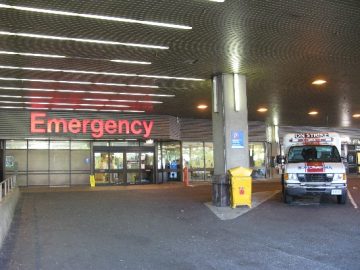 Emergency departments (EDs) in Canada treat roughly 20M patients per year, with 3M per year in BC. Pre-pandemic, average wait times were 2 to 3 hours. Many people avoided going to the ED during the pandemic, and conditions that may have been minor then have worsened, driving more patients to the ED. Compounding this are widespread cases of influenza stemming from a lack of exposure during the pandemic, and the prevalence of Respiratory Syncytial Virus Infection (RSV), particularly among children. The net result is ED wait times as high as 13 hours, sometimes with tragic results
Emergency departments (EDs) in Canada treat roughly 20M patients per year, with 3M per year in BC. Pre-pandemic, average wait times were 2 to 3 hours. Many people avoided going to the ED during the pandemic, and conditions that may have been minor then have worsened, driving more patients to the ED. Compounding this are widespread cases of influenza stemming from a lack of exposure during the pandemic, and the prevalence of Respiratory Syncytial Virus Infection (RSV), particularly among children. The net result is ED wait times as high as 13 hours, sometimes with tragic results
Patient flow is managed in the ED by triage nurses who stratify incoming patients based on a five-level scale, from the need for continuous monitoring to checking the patient every two hours. This approach requires crucial judgements to be made about patients, and is not sensitive to sudden changes in status. Related vital signs data are not stored or added to the patient’s record, so cannot be aggregated and used for future learning.

Dr. Kendall Ho
Dr. Kendall Ho, Digital Emergency Medicine lead in UBC’s Faculty of Medicine and a practicing ED physician at Vancouver General Hospital (VGH), is all too aware of these challenges. But he does see an opportunity presented by technological advances in computing power, artificial intelligence (AI), and the proliferation of virtual care during the pandemic.
The UBC-Rogers partnership on 5G research and development, managed by ICICS, has provided Dr. Ho with the means to leverage these advances. With a history of multidisciplinary team-based research focused on societal impact, the partnership is an ideal fit for Dr. Ho’s vision of partially automating patient monitoring and flow in the ED and beyond.

Professor Edmond Cretu
The partnership is supporting “Tx MED: Timely and Extended Monitoring in Emergencies and Disasters,” co-led by Dr. Ho and Professor Edmond Cretu of UBC’s Department of Electrical and Computer Engineering (ECE). The goal is to develop a low-cost wearable system that can be readily attached to patients and continually monitor vital signs such as heart rate/rhythm, blood pressure, oxygen saturation, temperature, and location. The collected data will be communicated over 5G or Wi-Fi networks to the cloud for AI-based analysis, then graphically displayed on a dashboard monitored by an ED nurse. Critical changes in patient status will trigger alerts showing the patient’s condition and location so they can receive the attention they need.
Learning from Patient Data
Current ED patient triage data are stored for individual patients, but cannot be easily collated for pattern analysis to enable machine learning. Tx MED, on the other hand, presents an opportunity to store and learn from anonymized individual and aggregate data. Patients with low blood pressure fluctuations over days and weeks, for example, are at lower risk that those with high fluctuations for developing heart diseases or strokes, but this can only be detected by continuous monitoring. At the aggregate level, anonymized data from 10,000+ patients who have had strokes may detect minute physiological changes that occur in patients with certain types of stroke through AI and machine learning, so they can be appropriately treated.
The Team-based Approach: Challenges and Opportunities
Tx MED requires expertise from two substantially different disciplines. Creating a wearable health status monitor requires engineering expertise to integrate the different sensors into a low-cost, low power, even disposable system that can send data wirelessly to the cloud. This work is being handled by Professors Cretu and Shahriar Mirabbasi of ECE and their students. Once in the cloud, patient data must be analyzed and visualized, which process engineering expert Professor Bhushan Gopaluni of Chemical and Biological Engineering is tackling.
Dr. Ho emphasizes the importance of integrating the engineering and clinical sides, and learning to talk to one another: “It is very important that we develop the technology to not only accurately measure patient physiological numbers and detect the flow of patients, but in such a way that it can be accurately embedded into the workflow of healthcare.” Dr. Ho, fellow ED physicians Chad Kim Sing and Christopher Lee, and ED nurses Lara Gurney and Julie Lockington are pooling their expertise to address these clinical questions. Post-doctoral students funded by Rogers and Mitacs are carrying out the day-to-day research tasks.
Tx MED is still in the early stages, with a focus on communicating vital signs data to the dashboard. Once proven out in the ED, Tx MED could scale to community-based use in mass casualty events such as fires and earthquakes. This would enable rapid, objective decisions to be made on prioritizing patients for transport, as well as the transmission of patient vital signs data to the ED before the patient arrives.
Convergence of engineers, clinicians, and healthcare organizations, driven by the near-term goals of an industry partner like Rogers, is essential to developing and implementing technologies such as Tx MED. As Dr. Ho says, “We have the research expertise, government and industry support, and public buy-in to transform the healthcare system. We can lead with technologies like Tx MED. Why not us?”
For more information on TxMED, contact Kendall Ho at kendall.ho@ubc.ca.